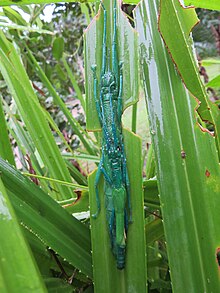| Megacrania | |
|---|---|

| |
| Adults mating at Cape Tribulation, Queensland, Australia | |
| Scientific classification | |
| Domain: | Eukaryota |
| Kingdom: | Animalia |
| Phylum: | Arthropoda |
| Class: | Insecta |
| Order: | Phasmatodea |
| Family: | Phasmatidae |
| Subfamily: | Megacraniinae |
| Genus: | Megacrania Kaup, 1871 |
Megacrania is a genus of the subfamily Megacraniinae of stick insects. Members of this genus are commonly referred to as "peppermint stick insects", due to the characteristic odor of their defensive spray, as well as the cylindrical, twig-like shape of their bodies.
These unusual insects are notable for their aposematic coloration, as well as their robust chemical defense mechanism. This mechanism consists of an irritating fluid — with an odor resembling peppermint — that they spray from a pair of scent glands located at the prothorax when threatened. This fluid is irritating or painful when inhaled or absorbed through mucous membranes, and is an effective deterrent against many arthropod, reptilian and avian predators.
Taxonomy
This genus was first described by Johann Jakob Kaup in 1871. After an exhaustive study, the genus Megacrania was revised in 2007. Among other revisions, M. batesii was removed from synonymy with M. alpheus. There are now 12 known species within the genus:
- M. alpheus
- M. artus
- M. batesii
- M. brocki
- M. nigrosulfurea
- M. obscurus
- M. phelaus (Westwood, 1859) - type species (as Platycrania phelaus Westwood)
- M. rentzi
- M. spina
- M. tsudai
- M. vickeri
- M. wegneri
The genus Megacrania was further revised in 2020, when it was transferred from subfamily Platycraninae to subfamily Megacraniinae (palm stick insects). The two tribes (Platycranini and Stephanacridini) within the former subfamily, Platycraninae, have been determined to be not closely related to the Megacraniinae.
References
- Dossey, Aaron T. (2011). "Chemical Defenses of Insects: A Rich Resource for Chemical Biology in the Tropics" (PDF). In Vivanco, Jorge M.; Weir, Tiffany (eds.). Chemical Biology of the Tropics: An Interdisciplinary Approach. Signaling and Communication in Plants. Vol. 8. Berlin Heidelberg: Springer-Verlag. pp. 27–57. doi:10.1007/978-3-642-19080-3. ISBN 978-3-642-19079-7.
- ^ Hsiung, Chia-Chi (2007). "Revision of the genus Megacrania Kaup (Cheleutoptera: Phasmatidae)". Journal of Orthoptera Research. 16 (2): 207–21. doi:10.1665/1082-6467(2007)16[207:ROTGMK]2.0.CO;2. JSTOR 20066587. S2CID 85588084.
- Dettner, Konrad (2015). "Toxins, Defensive Compounds and Drugs from Insects". In Hoffmann, Klaus H. (ed.). Insect Molecular Biology and Ecology. Boca Raton: Taylor & Francis. pp. 39–93. ISBN 978-1482231885.
- Kaup, Johann Jakob (1871). "Neue Phasmidae" (PDF). Berliner Entomologische Zeitschrift (in German). 15 (1): 25–42. doi:10.1002/mmnd.18710150107.
- Brock, Paul D.; Hasenpusch, Jack (2007). "Studies on the Australian stick insects (Phasmida), including a checklist of species and bibliography" (PDF). Zootaxa. 1570: 1–84. doi:10.11646/zootaxa.1570.1.1.
- Brock, P.D., Büscher, T. & Baker, E. (2020). "genus Megacrania Kaup, 1871". Phasmida Species File Online. Version 5.0/5.0. Retrieved 21 January 2021.
{{cite web}}: CS1 maint: multiple names: authors list (link) - "Megacraniinae —The Palm Stick Insects: A new subfamily of Old World Phasmatodea". The World of Stick Insects. Phasmatodea.com. 2020. Retrieved 10 January 2021.
External links
| Taxon identifiers | |
|---|---|
| Megacrania | |